Apr 13, 2025
Apr 13, 2025

Around 1000 AD, when the Classic Mayan civilization was at its lowest ebb, barbarians were knocking at the gates of Delhi, and Buddhism had all but migrated out of India, the Cholas were flowering in South India. In fact, this year marks the 1000th year of the consecration of the Brihadeshwara Temple in Thanjavur. Deemed a World Heritage Site by UNESCO, the Brihadeshwara Temple was built by the munificent king, Raja Raja Chola I and is a testament to the culture, art and prowess of the Chola Empire.
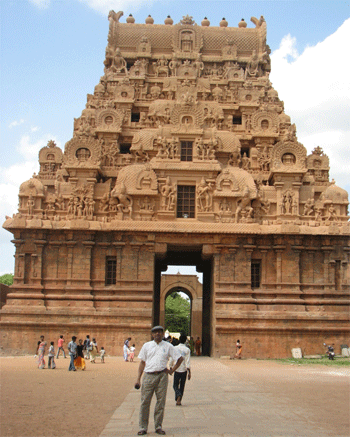 As you approach the gateway of the Brihadeshwara Temple, you can’t help noticing the remnants of what would have been a moat around a fortress. Despite the searing 100 degree heat in mid summer, upon entering the hallowed grounds, I was struck by the magnificence of the timeless monuments and completely transfixed by the architectural splendor of the carvings and intricate details. Standing in the center of the archway you are afforded a panoramic view of the quadrangle with its high walls rising against the background of tall, verdant coconut trees.
As you approach the gateway of the Brihadeshwara Temple, you can’t help noticing the remnants of what would have been a moat around a fortress. Despite the searing 100 degree heat in mid summer, upon entering the hallowed grounds, I was struck by the magnificence of the timeless monuments and completely transfixed by the architectural splendor of the carvings and intricate details. Standing in the center of the archway you are afforded a panoramic view of the quadrangle with its high walls rising against the background of tall, verdant coconut trees.
The towering Vimanam, or temple tower approximately 200 ft tall, filled with intricate carvings rises up to touch the blue skies and you are filled with nothing but wonder at such a megalithic structure! The features of the deities and other figures are so remarkable that it speaks volumes for the gifted ‘shilpi’ or sculptor.
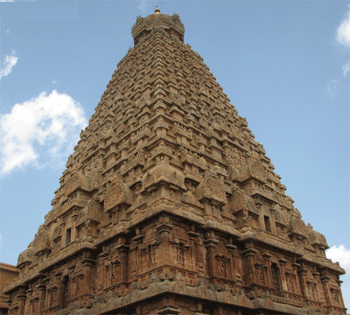 This Vimanam is probably the tallest of its kind and was made using granite, a stone that was not readily available in the nearby vicinity! Not only that, you are completely dwarfed by a gigantic Nandi or sacred bull of Shiva, carved out of a single rock that guards the temple entrance.
This Vimanam is probably the tallest of its kind and was made using granite, a stone that was not readily available in the nearby vicinity! Not only that, you are completely dwarfed by a gigantic Nandi or sacred bull of Shiva, carved out of a single rock that guards the temple entrance.
Imagine the royal celebrations that would have been held here several centuries back when the masses would congregate around the temple waiting for the King and the royal priest to arrive and perform the rites. Marvelling at the engineering precision of the monument, it is almost a déjà vu moment, as I remember coming to this place in my childhood, probably not all that excited in visiting yet another temple as my parents dragged me along. But this time it is a totally different experience as you surmise that you could spend the entire day here drinking in each and every detail, when suddenly your kids start tugging you telling you to move faster in search of a cool shelter. All at once, a cool breeze touches your face as you observe the tall trees sway gently. The pillared portico along the walls of this citadel are adorned with rich murals, some of which are incredibly preserved, reminiscent of Mayan Temple paintings, although in some places you can barely make out the outlines.
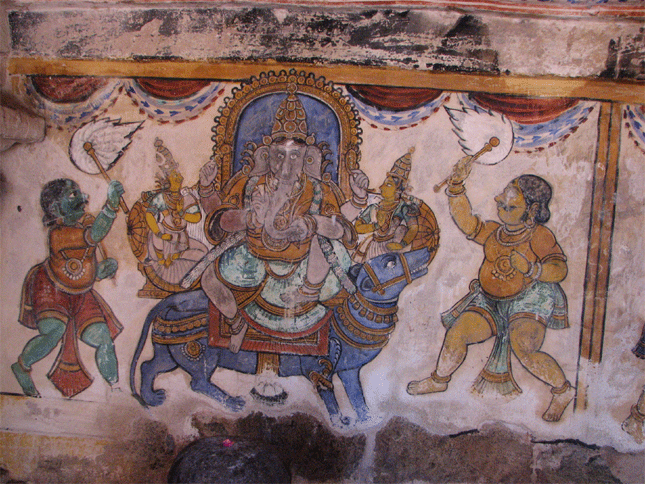
Like other empires, the Cholas too fought internecine wars with neighboring kingdoms, enjoyed their victories and bemoaned their losses, but they left indelible marks in India’s history, which have withstood the onslaught of the natural elements through several centuries.
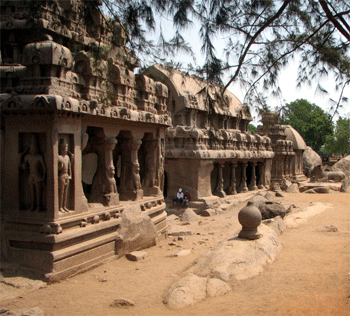 Driving up further northeast you reach Puducherry, the French bastion, with its cobblestone lined streets and alleys, replete with French stucco and stone buildings. Breezing along Goubert Avenue on the ocean front you arrive at the Pondicherry Museum, where you are treated to a wonderful collection of bronze and stone sculptures from the Chola and Pallava dynasties. Interestingly there is a collection of Roman coins, pottery, trinkets & beads from nearby Arikamedu, which probably served as a port city during the Chola and Pallava dynasties providing for maritime activity. The Romans are believed to have undertaken trade in this port city and elsewhere since the 1st century AD. I was looking forward to visit Arikamedu’s archaeological ruins which were excavated by Sir Mortimer Wheeler, of the Indus Valley fame, but the museum guide dissuaded me from going saying there wasn’t much left there, as most of it was already in the museum.
Driving up further northeast you reach Puducherry, the French bastion, with its cobblestone lined streets and alleys, replete with French stucco and stone buildings. Breezing along Goubert Avenue on the ocean front you arrive at the Pondicherry Museum, where you are treated to a wonderful collection of bronze and stone sculptures from the Chola and Pallava dynasties. Interestingly there is a collection of Roman coins, pottery, trinkets & beads from nearby Arikamedu, which probably served as a port city during the Chola and Pallava dynasties providing for maritime activity. The Romans are believed to have undertaken trade in this port city and elsewhere since the 1st century AD. I was looking forward to visit Arikamedu’s archaeological ruins which were excavated by Sir Mortimer Wheeler, of the Indus Valley fame, but the museum guide dissuaded me from going saying there wasn’t much left there, as most of it was already in the museum.
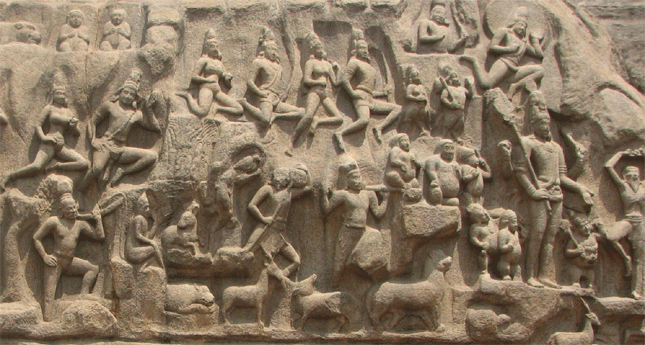
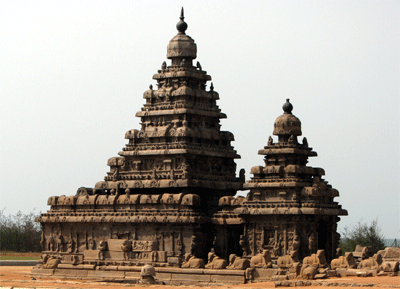 After a pleasant drive along the East Coast Road we reached Mamallapuram, formerly Mahabalipuram, the abode of the Pallavas in the 7th century AD. Built by Narasimhivarman I (Mamalla), each temple or structure is carved entirely out of monolithic rocks with bas-relief sculptures that is reminiscent of Buddhist architecture in Ajanta/Ellora. Mahabalipuram also has been recognized as a World Heritage site by UNESCO. There are distinct differences in the architecture of the Pallavas, who eventually gave way to the Cholas. The myth of Krishna holding up the Govardhan hillock is beautifully sculpted here inside one of the cave enclosure, complete with cowherds, maids, children and animals. The most famous of these sculptures is the Arjuna penance bas-relief and the Five Rathas each named after the Pandava princes. A monument of exquisite beauty, the Shore Temple stands all by itself in the sandy shores of the Bay of Bengal, a witness to centuries passing by.
After a pleasant drive along the East Coast Road we reached Mamallapuram, formerly Mahabalipuram, the abode of the Pallavas in the 7th century AD. Built by Narasimhivarman I (Mamalla), each temple or structure is carved entirely out of monolithic rocks with bas-relief sculptures that is reminiscent of Buddhist architecture in Ajanta/Ellora. Mahabalipuram also has been recognized as a World Heritage site by UNESCO. There are distinct differences in the architecture of the Pallavas, who eventually gave way to the Cholas. The myth of Krishna holding up the Govardhan hillock is beautifully sculpted here inside one of the cave enclosure, complete with cowherds, maids, children and animals. The most famous of these sculptures is the Arjuna penance bas-relief and the Five Rathas each named after the Pandava princes. A monument of exquisite beauty, the Shore Temple stands all by itself in the sandy shores of the Bay of Bengal, a witness to centuries passing by.
21-Feb-2010
More by : Subra Narayan

|
hi i love this site it help you find very correct facts for a history project |

|
A master piece of Cholas'. There are still many brilliant marvels like this Tanjur temple, which was not noticed and maintained. Hope you can provide with details as that like here. |